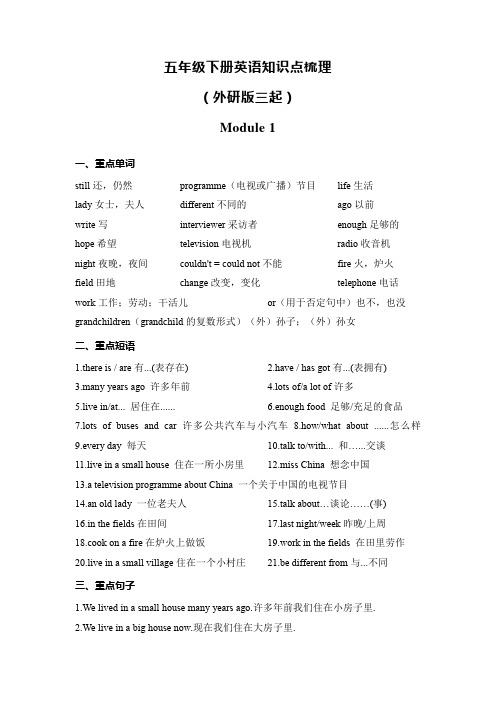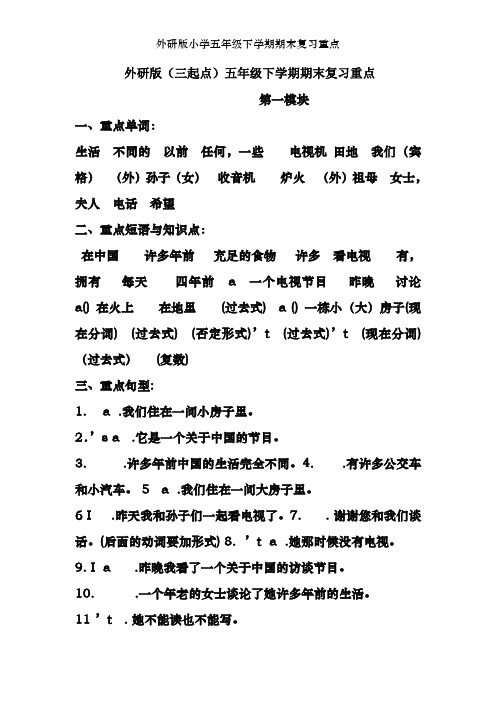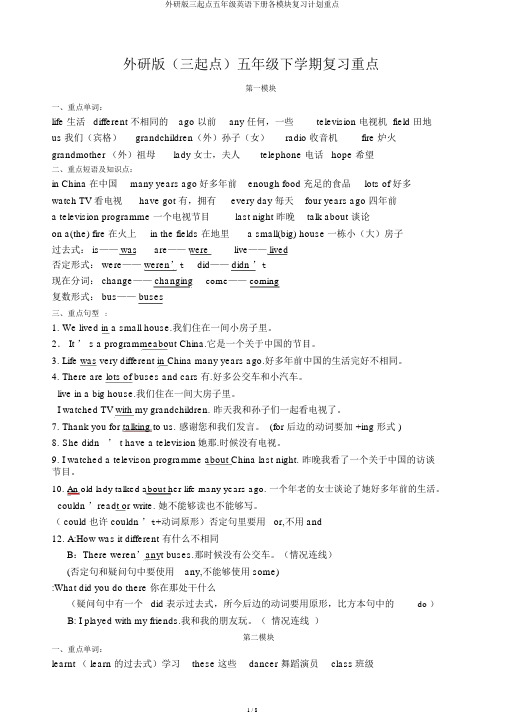(外研版)(三起点)五年级英语下册期末复习重点-非常好
新外研版(三起)英语五年级下册全册知识点归纳

五年级下册英语知识点梳理(外研版三起)Module 1一、重点单词still还,仍然programme(电视或广播)节目life生活lady女士,夫人different不同的ago以前write写interviewer采访者enough足够的hope希望television电视机radio收音机night夜晚,夜间couldn't = could not不能fire火,炉火field田地change改变,变化telephone电话work工作;劳动;干活儿or(用于否定句中)也不,也没grandchildren(grandchild的复数形式)(外)孙子;(外)孙女二、重点短语1.there is / are有...(表存在)2.have / has got有...(表拥有)3.many years ago 许多年前4.lots of/a lot of许多5.live in/at... 居住在......6.enough food 足够/充足的食品7.lots of buses and car许多公共汽车与小汽车8.how/what about ......怎么样9.every day 每天10.talk to/with... 和…...交谈11.live in a small house 住在一所小房里12.miss China 想念中国13.a television programme about China 一个关于中国的电视节目14.an old lady 一位老夫人15.talk about…谈论……(事)16.in the fields在田间st night/week昨晚/上周18.cook on a fire在炉火上做饭19.work in the fields 在田里劳作20.live in a small village住在一个小村庄21.be different from与...不同三、重点句子1.We lived in a small house many years ago.许多年前我们住在小房子里.2.We live in a big house now.现在我们住在大房子里.3.There weren't many buses.过去没有这么多的公共汽车。
外研版(三起点)五年级下学期期末复习重点-

外研版(三起点)五年级下学期期末复习重外研版(三起点)五年级下学期期末复习重点第一模块一、重点短语及知识点:in China 在中国many years ago 许多年前eno ugh food 充足的食物lots of 许多watch TV 看电视have got 有,拥有every day 每天four years ago 四年前live(过去式)lived a televisi onprogramme 一个电视节目last ni ght 昨晚talk about 讨论on a(the) fire 在火上in thefields 在地里a small(big) house 一栋小(大)房子come(现在分词)coming are(过去式)were were(否定形式)weren ' t did(过去式)didn ' t change(现在分词)chinging is (过去式)was bus(复数)buses 二、重点句型:1. Welived in a small house.我们住在一间小房子里。
2 . It ' s a programme about China.它是一个关于中国的节目。
3. Life was very differe nt in China many years ago. 许多年前中国的生活完全不同。
4. There are lots of buses and cars.有许多公交车和小汽车。
5. We live in a big house. 我们住在一间大房子里。
6. Y esterday I watched TV with my gran dchildre n. 昨天我禾口孙子们一起看电视了。
7. Tha nk you for talk ing to us. 谢谢您和我们谈话。
(for 后面的动词要加+ing 形式)8. She didn ' t have a television .她那时候没有电视。
外研版(三起点)五年级下学期期末复习重点

外研版(三起点)五年级下学期期末复习重点第一模块一、重点单词:life生活different不同的ago以前any任何,一些television电视机field田地us我们(宾格)grandchildren(外)孙子(女)radio收音机fire炉火grandmother(外)祖母lady女士,夫人telephone电话hope希望二、重点短语及知识点:in China在中国many yearsago许多年前enough food充足的食物lots of许多watch TV看电视have got 有,拥有every day每天four years ago四年前a televisionprogramme一个电视节目lastnight昨晚talkabout讨论on a(the)fire在火上in the fields在地里live(过去式)liveda small(big) house一栋小(大)房子come(现在分词)comingare(过去式)werewere(否定形式)weren’tdid(过去式)didn’tchange(现在分词)chingingis(过去式)wasbus(复数)buses三、重点句型:1. Welived inasmallhouse.我们住在一间小房子里。
2.It’s a programme about China.它是一个关于中国的节目。
3. Life was verydifferent in Chinamanyyearsago.许多年前中国的生活完全不同。
4.There are lots of busesandcars.有许多公交车和小汽车。
5.Welive inabig house.我们住在一间大房子里。
6.YesterdayI watched TV with my grandchildren.昨天我和孙子们一起看电视了。
7. Thank you for talkingto us. 谢谢您和我们谈话。
外研版小学五年级下学期期末复习重点

外研版(三起点)五年级下学期期末复习重点第一模块一、重点单词:生活不同的以前任何,一些电视机田地我们(宾格)(外)孙子(女)收音机炉火(外)祖母女士,夫人电话希望二、重点短语与知识点:在中国许多年前充足的食物许多看电视有,拥有每天四年前 a 一个电视节目昨晚讨论a() 在火上在地里(过去式) a () 一栋小(大)房子(现在分词) (过去式) (否定形式)’t (过去式)’t (现在分词) (过去式)(复数)三、重点句型:1. a .我们住在一间小房子里。
2.’s a .它是一个关于中国的节目。
3. .许多年前中国的生活完全不同。
4. .有许多公交车和小汽车。
5 a .我们住在一间大房子里。
6 I .昨天我和孙子们一起看电视了。
7. . 谢谢您和我们谈话。
(后面的动词要加形式) 8. ’t a .她那时候没有电视。
9. I a .昨晚我看了一个关于中国的访谈节目。
10. .一个年老的女士谈论了她许多年前的生活。
11 ’t . 她不能读也不能写。
(或者’t后面要加动词原形)否定句里要用 ,不用)12. ?有什么不同?B:’t .那时候没有公交车。
(否定句和疑问句中要使用,不能使用)13 ?三天前你在哪里?B: I .我在邱家沟。
14 ?你在那里干什么?(疑问句中有一个表示过去式,所以后面的动词要用原形,例如本句中的) B: I .我和我的朋友玩。
第二模块一、重点单词:(的过去式)学习这些舞蹈演员班级学习努力的退休的二、重点短语与知识点:中国城市 (复数) 外语五年前乘校车步行去学校 a 读书 a 做蛋糕(过去式) (过去式) (现在分词) (过去式) (过去式) (过去式) (三单) (名词)三、重点句型:1: ?她为什么要穿这些衣服呢? B: a .因为她是个舞蹈演员。
(重点加情连) 2 .她在中国许多城市跳过舞。
3. A: ?你奶奶学过英语吗? B: .\ ’t.4. .他现在正在学习英语。
外研版三起点五年级英语下册各模块复习计划重点

外研版(三起点)五年级下学期复习重点第一模块一、重点单词:life 生活 different 不相同的ago 以前any 任何,一些television 电视机 field 田地us 我们(宾格)grandchildren(外)孙子(女)radio 收音机fire 炉火grandmother (外)祖母lady 女士,夫人telephone 电话 hope 希望二、重点短语及知识点:in China 在中国many years ago好多年前enough food 充足的食品lots of 好多watch TV 看电视have got 有,拥有every day 每天four years ago 四年前a television programme 一个电视节目last night 昨晚talk about 谈论on a(the) fire 在火上in the fields 在地里 a small(big) house一栋小(大)房子过去式: is—— was are—— were live—— lived否定形式: were—— weren’t did—— didn ’t现在分词: change—— changing come—— coming复数形式: bus—— buses三、重点句型:1. We lived in a small house.我们住在一间小房子里。
2. It ’ s a programmeabout China.它是一个关于中国的节目。
3.Life was very different in China many years ago.好多年前中国的生活完好不相同。
4.There are lots of buses and cars有.好多公交车和小汽车。
live in a big house.我们住在一间大房子里。
I watched TV with my grandchildren. 昨天我和孙子们一起看电视了。
外研版(三起点)五年级英语下册各模块复习重点

外研版(三起点)五年级下学期复习重点第一模块一、重点单词:life生活different不同的ago以前any任何,一些television电视机field田地us我们(宾格)grandchildren(外)孙子(女)radio收音机fire炉火grandmother(外)祖母lady女士,夫人telephone电话hope希望二、重点短语及知识点:in China在中国many years ago许多年前enough food充足的食物lots of许多watch TV看电视have got有,拥有every day每天four years ago四年前a television programme一个电视节目last night昨晚talk about讨论】on a(the) fire在火上in the fields在地里 a small(big) house一栋小(大)房子过去式:is——was are——were live——lived否定形式:were——weren’t did——didn’t现在分词:change——changing come——coming复数形式:bus——buses三、重点句型:1.We lived in a small house.我们住在一间小房子里。
2.It’s a programme about China.它是一个关于中国的节目。
3. Life was very different in China many years ago.许多年前中国的生活完全不同。
4. There are lots of buses and cars.有许多公交车和小汽车。
(live in a big house.我们住在一间大房子里。
I watched TV with my grandchildren.昨天我和孙子们一起看电视了。
7. Thank you for talking to us.谢谢您和我们谈话。
外研版五年级英语下册期末复习重点教学提纲
外研版五年级英语下册期末复习重点外研版(三起点)五年级下学期期末复习重点第一模块一、重点单词:life生活 different不同的 ago以前 any任何,一些 television电视机 field田地 us我们(宾格) grandchildren(外)孙子(女)radio收音机 fire炉火grandmother(外)祖母 lady女士,夫人telephone电话 hope希望二、重点短语及知识点:in China在中国 many years ago许多年前 enough food充足的食物lots of许多 watch TV看电视 have got 有,拥有 every day每天 four years ago四年前 a television programme一个电视节目last night昨晚 talk about讨论 on a(the) fire在火上 in the fields在地里 live(过去式)liveda small(big) house一栋小(大)房子come(现在分词)coming are(过去式)were were(否定形式)weren’t did(过去式)didn’t change(现在分词)chinging is(过去式)was bus(复数)buses三、重点句型:1. We lived in a small house.我们住在一间小房子里。
2.It’s a programme about China.它是一个关于中国的节目。
3. Life was very different in China many years ago.许多年前中国的生活完全不同。
4. There are lots of buses and cars.有许多公交车和小汽车。
5.We live in a big house.我们住在一间大房子里。
6.Yesterday I watched TV with my grandchildren.昨天我和孙子们一起看电视了。
(外研版)(三起点)五年级英语下册期末复习重点
外研版(三起点)五年级下学期期末复习重点第一模块一、重点单词:life生活different不同的ago以前any任何,一些television电视机field田地us我们(宾格)grandchildren(外)孙子(女)radio收音机fire炉火grandmother(外)祖母lady女士,夫人telephone电话hope希望二、重点短语及知识点:in China在中国many years ago许多年前enough food充足的食物lots of许多watch TV看电视have got有,拥有every day每天four years ago四年前a television programme一个电视节目last night昨晚tal about讨论on a(the) fire在火上in the fields在地里 a small(big) house一栋小(大)房子过去式:is——was are——were live——lived否定形式:were——weren’t did——didn’t现在分词:change——chinging come——coming复数形式:bus——buses三、重点句型1.We lived in a small house.我们住在一间小房子里。
2.It’s a programme about China.它是一个关于中国的节目。
3. Life was very different in China many years ago.许多年前中国的生活完全不同。
4. There are lots of buses and cars.有许多公交车和小汽车。
5.We live in a big house.我们住在一间大房子里。
6.Yesterday I watched TV with my grandchildren.昨天我和孙子们一起看电视了。
7. Than you for taling to us.谢谢您和我们谈话。
(外研版)(三起点)五年级英语下册期末复习重点【精校】
外研版(三起点)五年级下学期期末复习重点第一模块一、重点单词:life生活different不同的ago以前any任何,一些television电视机field田地us我们(宾格)grandchildren(外)孙子(女)radio收音机fire炉火grandmother(外)祖母lady女士,夫人telephone电话hope希望二、重点短语及知识点:in China在中国many years ago许多年前enough food充足的食物lots of许多watch TV看电视have got有,拥有every day每天four years ago四年前a television programme一个电视节目last night昨晚tal about讨论on a(the) fire在火上in the fields在地里 a small(big) house一栋小(大)房子过去式:is——was are——were live——lived否定形式:were——weren’t did——didn’t现在分词:change——chinging come——coming复数形式:bus——buses三、重点句型1.We lived in a small house.我们住在一间小房子里。
2.It’s a programme about China.它是一个关于中国的节目。
3. Life was very different in China many years ago.许多年前中国的生活完全不同。
4. There are lots of buses and cars.有许多公交车和小汽车。
5.We live in a big house.我们住在一间大房子里。
6.Yesterday I watched TV with my grandchildren.昨天我和孙子们一起看电视了。
7. Than you for taling to us.谢谢您和我们谈话。
最新外研版(三起点)五年级下学期期末复习重点
外研版(三起点)五年级下学期期末复习重点第一模块一、重点单词:life生活different不同的ago以前any任何,一些television电视机field田地us我们(宾格)grandchildren(外)孙子(女)radio收音机fire炉火grandmother(外)祖母lady女士,夫人telephone电话hope希望二、重点短语及知识点:in China在中国many years ago许多年前enough food充足的食物lots of许多watch TV看电视have got 有,拥有every day每天four years ago四年前a television programme一个电视节目last night昨晚talk about讨论on a(the) fire在火上in the fields在地里live(过去式)liveda small(big) house一栋小(大)房子come(现在分词)comingare(过去式)werewere(否定形式)weren’tdid(过去式)didn’tchange(现在分词)chingingis(过去式)wasbus(复数)buses三、重点句型:1. We lived in a small house.我们住在一间小房子里。
2.It’s a programme about China.它是一个关于中国的节目。
3. Life was very different in China many years ago.许多年前中国的生活完全不同。
4. There are lots of buses and cars.有许多公交车和小汽车。
5.We live in a big house.我们住在一间大房子里。
6.Yesterday I watched TV with my grandchildren.昨天我和孙子们一起看电视了。
7. Thank you for talking to us. 谢谢您和我们谈话。
- 1、下载文档前请自行甄别文档内容的完整性,平台不提供额外的编辑、内容补充、找答案等附加服务。
- 2、"仅部分预览"的文档,不可在线预览部分如存在完整性等问题,可反馈申请退款(可完整预览的文档不适用该条件!)。
- 3、如文档侵犯您的权益,请联系客服反馈,我们会尽快为您处理(人工客服工作时间:9:00-18:30)。
外研版(三起点)五年级下学期期末复习重点第一模块一、重点单词:life 生活 different 不同的 ago 以前 any 任何,一些 television 电视机 field 田地 us 我们(宾格)grandchildren (外)孙子(女) radio 收音机 fire 炉火 grandmother (外)祖母 lady 女士,夫人 telephone 电话 hope 希望二、重点短语及知识点:in China 在中国 many years ago 许多年前 enough food 充足的食物 lots of 许多 watch TV 看电视have got 有,拥有 every day 每天 four years ago 四年前 a television programme 一个电视节目last night 昨晚 tal about 讨论on a(the) fire 在火上 in the fields 在地里 a small(big) house 一栋小(大)房子过去式: is ——was are —— were live —— lived 否定形式: were—— weren't did —— didn 't 现在分词: change—— chinging come —— coming 复数形式: bus—— buses三、重点句型1.We lived in a small house. 我们住在一间小房子里。
2.It ' s a programme about China. 它是一个关于中国的节目。
3.Life was very different in China many years ago. 许多年前中国的生活完全不同。
4.There are lots of buses and cars. 有许多公交车和小汽车。
5.We live in a big house. 我们住在一间大房子里。
6.Yesterday I watched TV with my grandchildren. 昨天我和孙子们一起看电视了。
7.Than you for taling to us. 谢谢您和我们谈话。
(for 后面的动词要加 +ing 形式)8.She didn ' t have a television . 她那时候没有电视。
9.I watched a televison programme about China last night. 昨晚我看了一个关于中国的访谈节目。
10.An old lady taled about her life many years ago. 一个年老的女士谈论了她许多年前的生活。
11.She couldn 't read or write. 她不能读也不能写。
could 或者 couldn 't + 动词原形)否定句里要用 or, 不用 and12.AHow was it different? 有什么不同?B:There weren' t any buses. 那时候没有公交车。
(情景连线)(否定句和疑问句中要使用 any, 不能使用 some)13. A Where were you three days ago? 三天前你在哪里?B I was in Qiu Jiagou . 我在邱家沟。
(情景连线)14.AWhat did you do there? 你在那里干什么?(疑问句中有一个 did 表示过去式,所以后面的动词要用原形,例如本句中的 do) B I played with my friends. 我和我的朋友玩。
(情景连线)第二模块一、重点单词:learnt ( learn 的过去式)学习 these 这些 dancer 舞蹈演员 class 班级 study 学习 hard 努力的retired 退休的二、重点短语及知识点:Chinese city 中国城市 city(复数)cities foreign languages 外语 five years ago by school bus 乘校车 wal to school 步行去学校 read a boo 读书 mae a cae 做蛋糕过去式: dance—— danced learn —— learnt mae —— made teach —— taught 现在分词:learn —— learning study —— studied go(第三人称单数形式)goes dance (名词形式)dancer三、重点句型1. A Why is she wearing these clothes? 她为什么要穿这些衣服呢?B Because she was a dancer. 因为她是个舞蹈演员。
(重点加情连)2.She danced in lots of Chinese cities. 她在中国许多城市跳过舞。
3. A Did your grandma learn English? 你奶奶学过英语吗?B Yes,she did . / No,she did in ' t.(情景连线)4.Hei s learning English now.他现在正在学习英语。
( now表示现在进行时,所以 learn+ing )5.Chen Hai is an English teacher. 陈海是一位英语老师。
(English 前面要用 an )6.Now he goes to school by school bus. 他现在坐校车去上学。
(三单形式)7.AWho are they? 他们是谁?BThey're my grandparents. 他们是我的爷爷奶奶。
(情景连线)8. A Who's this? 这是谁?BIt ' s my grandma. 这是我奶奶。
(情景连线)9. A Is this your grandpa? 这是你爷爷吗?B Yes,it is. 是的。
(情景连线)10.AWhat did she do yesterday? 她昨天干什么了? B She made a cae. 她做了个蛋糕。
(情景连线)第三模块一、重点单词:egg鸡蛋 email 电子邮件 sandwich 三明治 traditional 传统的 delicious 美味的,可口的hamburger 汉堡 ate ( eat 的过去式)吃 gave (give 的过去式)给 tonight 在今夜,今晚 dran (drin 的过去式)二、重点短语及知识点:an email 一封邮件 English food 英国食物 an English breafast 一顿英国早餐at school 在学校 a traditional English dinner 一顿传统的英国晚餐Chinese food 中国食物 last night 昨晚过去式: have—— had do ——did eat —— ate give —— gave buy —— bought 第三人称单数形式: do—— does say —— sayssandwich(复数) sandwiches does(否定形式)doesn ' t三、重点句型1.AWhat did she have for breafast? 她早餐吃的什么?BShe had eggs and sausages. 她吃的鸡蛋和香肠。
(情景连线)2.I have got an email from Lingling. 我收到玲玲的邮件。
3.Yesterday she had an English breafast. 昨天她吃了一顿英国早餐。
4.ADoes Lingling lie English food? 玲玲喜欢英国食物吗?B Yes,she does.\No,she doesn 't. 是的,她喜欢。
不,她不。
(情景连线)5.AWhat did you have for breafast yesterday? 你昨天早晨吃的什么?BI had eggs 我吃的鸡蛋。
(情景连线) 6. Today Sam ate si hamburgers at school.今天山姆在学校吃了六个汉堡包。
7. We gave our hamburgers to Sam. 我们把我们的汉堡包给了山姆。
8. Tonight Mum is going to coo Chinese food for Lingling. 今晚妈妈打算给玲玲做中国食物。
9. AWhat did you eat\drin last night? B I ate\dran ⋯我吃的 喝的⋯(情景连线)10. AWhat are you going to eat\drin tonight?dictionary 字典二、重点短语及知识点:on the CD-ROM 在光盘上 at the oo 在动物园 in the newspaper 在报纸上 on the computer 在电脑上 on TV 在电视上 buy ( 过去式 )bought三、重点句型1.AWhere are the boos about computers,please?请问电脑书在哪里?BThey are on Shelf C. 在 C 书架上。
(情景连线) 2. I want to mae an e-card for Mum.我想给妈妈做一张电子卡片。
(want 后面加 to,to 后面则用动词原形 mae; e-card 前要用 an 修饰,不用 a. ) 3. Let ' s go to the library. 让我们去图书馆吧。
( let 's 后面加动词原形) 4.We can find a boo about e-cards there. 在那里昨晚你吃的 喝的 什么?你今晚打算吃 喝什么?BI ' m going to eat\drin⋯我打算吃 喝⋯(情景连线)第四模块、重点单词:library 图书馆 find 找到 CD-ROM 电脑光盘 bring 带,拿 newspaper 报纸use 使用 card 卡片 easy 简单的 information 信息 timetable 时间表,时刻表 mae an e-card 做电子卡片 good at 擅长于 go to the library 去图书馆on Shelf C 在 C书架上 library card图书证 bring bac 带回in two wee 's time 两周内 find out找出 Chinese word 汉字 in the timetable 在信息表里 in the dictionary 在字典里我们能找到关于电子卡片的书。
